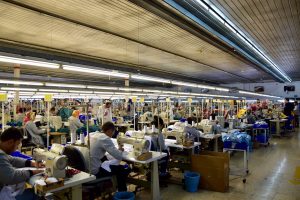Katie Crockford
Over the past several months, I have continuously heard more and more about humans’ high (and rapidly increasing) amounts of damage to planet Earth. We cut down too many trees, waste too much water, drive too often and emit hazardous gases, forget to turn off light switches, eat too much meat and fish, leave the water running while we brush our teeth, etc. While some of these are more detrimental than others and some seem more reasonable for a college student to fix, I have challenged myself to live as sustainably as possible. I’ve found myself doing little tasks such as turning the lights off when I leave a room or making sure I take as quick a shower as possible to conserve water. However, most of all, I have trained myself to constantly be thinking about sustainability and to make a conscious effort to consider it in all aspects of my life. In doing so, I recently started thinking about sustainability in the clothing and fashion industry. I began to do a little research and found myself appalled at not only the lack of sustainability in the clothing industry, but how many steps there are in the process of producing clothes. As a result, there is plenty of room for sustainable errors in clothing production. In society today, there is a lot of emphasis on producing as many goods as possible in as little time as possible, which can sacrifice environmental and human health. When breaking down the steps of clothing production, there are a lot of steps and questions to consider. Are the designers using sustainable materials or online resources when possible in place of paper? Are the manufacturers using sustainable, energy efficient equipment and tools to make clothing, shoes, jewelry, etc.? What materials are the finished products being shipped in? Are they held in storage anywhere in the process? If so, where and why?

Though a lot of these things feel a little bit out of my control and difficult to change on a large level, I have challenged myself to think about ways in which I can help with this particular issue in sustainability. I have tried to take better care of my clothes in order to make them last longer, and when I am done with them, I have started considering donation/recycling options instead of throwing them away. I have passed down old clothes and shoes to family members and friends. Whatever I have left after that, I try to donate somewhere not only so they don’t go to waste but also to hopefully help someone else in need. I have been able to take an issue that I felt I couldn’t impact and apply it to my everyday life. I have changed my shopping habits, started investigating how different brands of clothing are made, and encouraged my friends and family members to do the same. Many small steps towards being more sustainable make a big difference!
Sources
“Fashion’s 7 Priorities To Achieve Sustainability.” The Business of Fashion, The Business of Fashion, 27 Mar. 2018, www.businessoffashion.com/articles/news-analysis/fashions-7-priorities-to-achieve-sustainability.
“SEVEN FORMS OF SUSTAINABLE FASHION.” Green Strategy Sustainable and Circular Fashion Consulting, www.greenstrategy.se/sustainable-fashion/seven-forms-of-sustainable-fashion/.
“The Story Behind the Label.” The Story Behind the Label, www.thestorybehindthelabel.com/labels/2016/1/18/how-does-mass-production-in-clothes-works.
“WHAT IS SUSTAINABLE FASHION?” Green Strategy Sustainable and Circular Fashion Consulting, www.greenstrategy.se/sustainable-fashion/what-is-sustainable-fashion/.